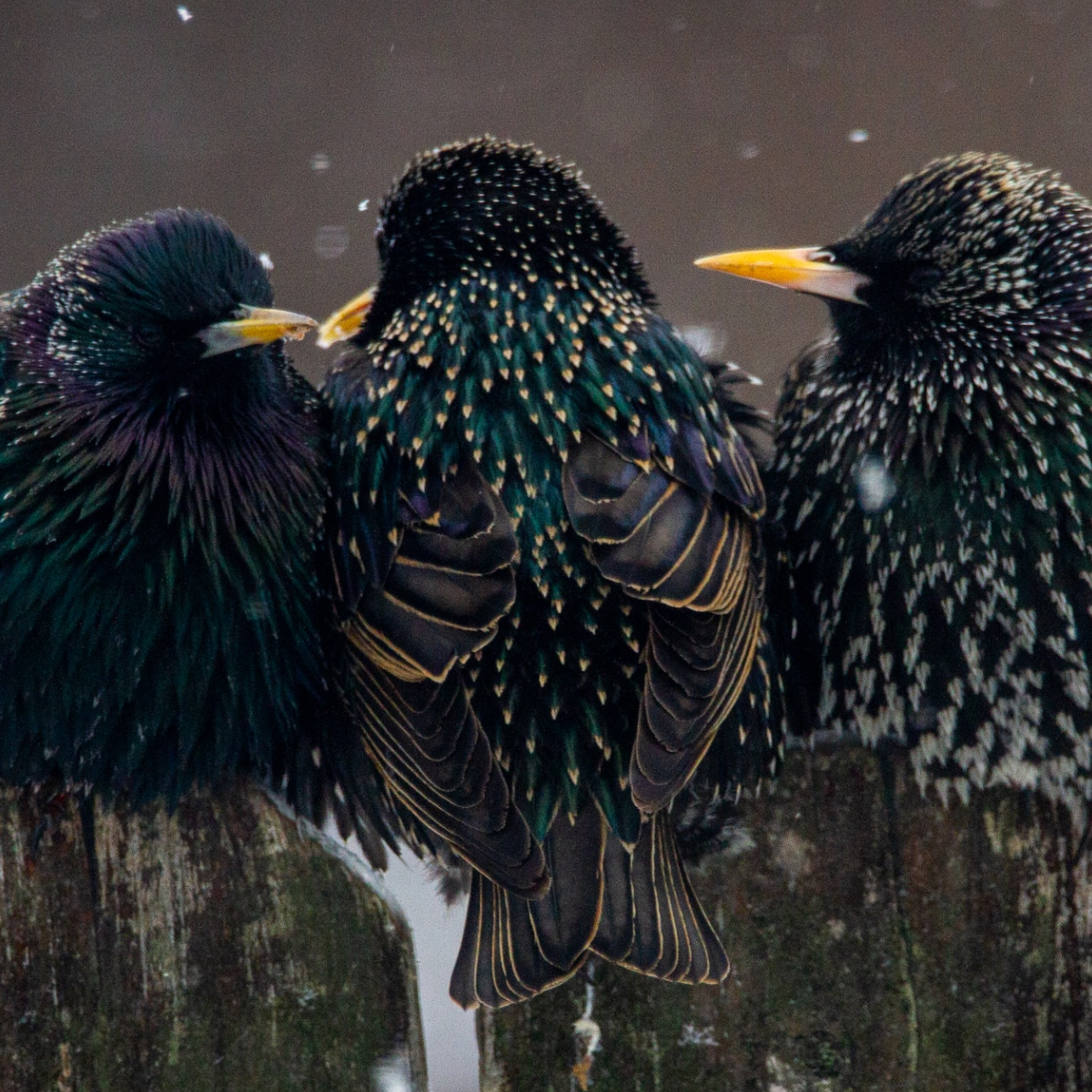The birds of Rhiannon are magical birds referenced in the Mabinogion, a collection of medieval Welsh tales. As their name implies, these birds are linked to Rhiannon, an otherworldly woman who plays a prominent role in the Mabinogion.
A Brief Description of the Mabinogion
The Mabinogion includes eleven Welsh tales that originally appeared in two manuscripts: the White Book of Rhydderch (c. 1350) and the Red Book of Hergest (1382-c. 1410). It has been translated from Welsh to English many times over the years, but the two versions I’m most acquainted with are those completed by Lady Charlotte Guest in the nineteenth century and by Sioned Davies in 2007. Because it is more contemporary in names and language, I shall be using Davies’ translation when citing from tales in the Mabinogion.
Four of the tales in the Mabinogion are known as “The Four Branches of the Mabinogi.” (When Lady Charlotte Guest completed her translation, she used the title, Mabinogion, because she believed it to be the plural form of mabinogi.) Several of the remaining stories are Arthurian in nature. And many of the tales incorporate myth, folklore, and legends into their narratives.
What Do We Know About the Birds of Rhiannon?

We initially encounter the birds of Rhiannon in “The Second Branch of the Mabinogi.” While their species is unknown, the birds of Rhiannon are songbirds, and their singing can charm the listener for years at a time. There is a passage in this tale where the birds captivate the surviving warriors who have returned to Britain from a war in Ireland. For seven years, as these warriors feast in Harlech (located on the coast in North Wales), the birds of Rhiannon sing to them:
Then they went to Harlech, and sat down and were regaled with food and drink. As soon as they began to eat and drink, three birds came and began to sing them a song, and all the songs they had heard before were harsh compared to that one. They had to gaze far out over the sea to catch sight of the birds, yet their song was as clear as if the birds were there with them. And they feasted for seven years.
In her Masters thesis, “Magical birds as a link between the Mabinogion and other Celtic literature: facts and fancies,” Elaine S. Eichner explains that while the text does not precisely link the birdsong to the passage of time, it seems that the birds’ spellbinding capability kept the warriors from being aware that seven years had passed as well as from feeling any sorrow from what they’d endured in the war.
Additional Mentions of the Birds of Rhiannon in the Mabinogion
While the feast at Harlech is the birds’ only appearance in “The Four Branches of the Mabinogi,” they are mentioned by name in one other story in the Mabinogion. In the Arthurian tale, “How Culhwch Won Olwen,” the birds of Rhiannon are named during a long passage of dialogue between Culhwch and the giant Ysbaddaden (Olwen’s father). Culhwch is living under a curse and can only marry Olwen; however, Ysbaddaden is destined to die when his daughter, Olwen, marries. A conundrum to be sure! In an effort to keep the marriage from happening, Ysbaddaden gives Culhwch a long list of impossible tasks, which must be completed in order for him to marry Olwen. One of them involves the birds of Rhiannon:
‘Though you may get that, [Ysbaddaden is referring to the previous task] there is something you will not get.
I want the birds of Rhiannon, they that wake the dead and lull the living to sleep, to entertain me that night.’
‘It is easy for me to get that, though you may think it’s not easy.’ [Culhwch’s response]
Through this interchange we learn a bit more about the birds’ magical powers. They can “wake the dead and lull the living to sleep” in addition to their ability to suspend reality over time and distance as we saw during the feast in Harlech. Unfortunately, the completion of this task is not depicted in the tale, and so we do not learn any more about the magical birds. The story does relate how Arthur, Culhwch’s cousin, helps complete the list of tasks (only some are described in the story). In the end, Culhwch marries Olwen and Ysbaddaden dies.
Although these are the only two stories in the Mabinogion that explicitly name the birds of Rhiannon, there is a third tale which references birds of a similar nature. In “The Lady of the Well” there are several passages describing how a “flock of birds will alight on the tree,” and the observer will have never experienced “such singing as theirs.” In her explanatory notes on the tale, Davies likens these birds to the birds of Rhiannon, explaining that birdsong “is often associated with the Otherworld.”
Eichner asserts that beyond these three instances, “… we have no reliable medieval sources for them [the birds of Rhiannon] outside of the Mabinogion.”
Who Is Rhiannon?
Looking to Rhiannon herself for more information on these magical birds does not provide ready answers. To begin with, there are no stories in which Rhiannon and her birds appear together. In addition, Rhiannon is generally considered a Celtic horse-goddess, which we can see evidence of in her initial appearance in “The First Branch of the Mabinogi.” In Davies’ translation, Rhiannon appears dressed in “a shining golden garment of brocaded silk” and rides “on a big, tall, pale-white horse.” Her horse seems to move at “slow, steady, pace”—yet, another rider in the tale cannot catch up to her, regardless of how quickly he rides. Throughout the tale Rhiannon is continually connected to horses in different ways, but not to her magical birds.

Jessica Hemming, in her article “Reflections on Rhiannon and the Horse Episodes in ‘Pwyll,’” explains how Rhiannon became linked with horses. (Just to clarify, in Guest’s translation, the “The First Branch of the Mabinogi” is titled “Pwyll Prince of Dyved.”):
The prevailing interpretation of this material is that Rhiannon is the literary descendant of a British goddess called *Rigantona (roughly, “Great Queen”) who was herself a regional variant of the widely-attested Continental divinity Epona whose mythic affinity to horses has never been seriously in dispute.
Rhiannon’s Connection to These Magical Birds Is Unclear
So I wondered then, how did Rhiannon become linked with three magical birds? Eichner ponders this question in her work as well, but does not seem to find a definitive answer. For example, she examines both Rhiannon’s and Epona’s relationship with birds, but finds them lacking in similarities. While the birds of Rhiannon are songbirds, Epona is only pictorially depicted with birds on two occasions—a pair of ducks in one and a single crow in the other—neither of which are considered songbirds.
I then turned to Hemming, who draws an interesting, otherworldly connection between Rhiannon’s horse and the birds. She notes:
The defining feature of Rhiannon’s horse is the deceptiveness of its speed. This may be part of the general phenomenon of temporal (and spatial) distortion which typically accompanies mortal intrusion into the Otherworld, especially—but not exclusively—in Celtic tradition. Most frequently, a person enters some Otherworldly realm (a fairy mound, a magic island, etc.) and spends a few hours or days, but returns home to discover that years, or even centuries, have passed on earth.
She then likens this distortion of time concept to both Rhiannon’s horse and her birds. The horse has the ability to move quickly while appearing to move slowly. Similarly, during the feast at Harlech, the birds seemed to be physically far away, but their song was easily heard as if they were nearby.
Perhaps at one time there existed tales which explained more about the birds of Rhiannon. As very little information regarding them has survived through the centuries, the birds remain elusive—it is unclear how they are linked to Rhiannon or what their origin myth is. But perhaps the fact that there are few references to them in medieval Welsh literature only adds to their intrigue.
Listen to a Folktale: “The Spectre Bridegroom”
I had another opportunity to be a guest reader for the Stories from the Hearth podcast, which is produced by The Folklore Podcast. Stories from the Hearth is a book-at-bedtime style podcast offering readings of folk and fairy tales. The folktale I read is called “The Spectre Bridegroom.” I had such fun recording it!


In this tale, a young couple in love are kept apart. The man dies, but the woman is not told about his death. One night, his spectre visits her on horseback, and she joins him thinking it’s truly her beloved. As the horse races through the night, the woman comes to realize that she’s on a wild ride with the spirit of the man she had loved.
Stories from the Hearth can be found on The Folklore Podcast’s Patreon, but it’s free to listen to. I think you might need to sign up as a free member, but that’s all.
Photo credit (featured image): photo by Joshua J. Cotten via Unsplash, licensed under the Unsplash License
This post was originally published on April 19, 2023.
It has been updated on September 18, 2024.




